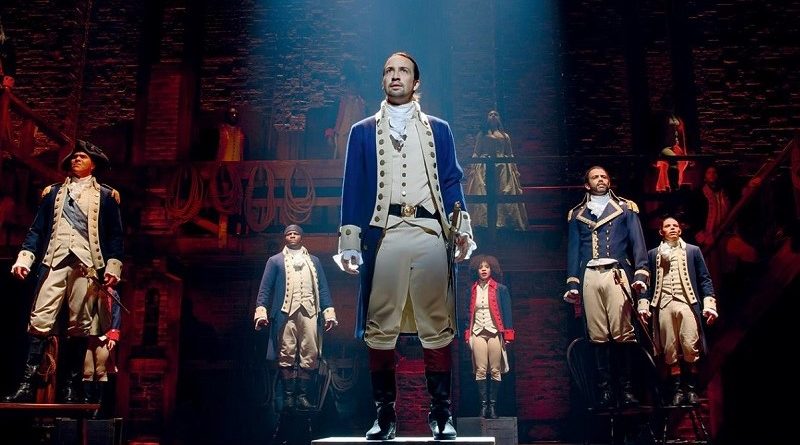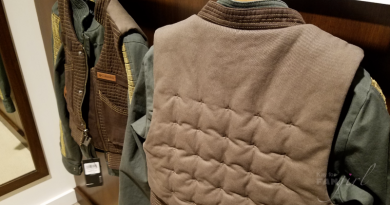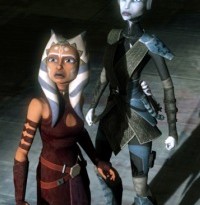May Hamilton Be With You: A Discussion on the Hit Musical, Star Wars, and the Past

Star Wars fans know a thing or two about being a fan, to love something so much that we find ways to talk about that love in every situation. This year a new obsession took the world by storm, a little Broadway show called Hamilton. A hip-hop musical about one of America’s founding fathers, this show is a powerhouse of storytelling through music, history, emotion, and performance.
Hamilton: An American Musical shares a few things with Star Wars beyond Hamilton’s creator, Lin Manuel Miranda, and J. J. Abrams’ composing and singing “Jabba Flow” in The Force Awakens. For example, both share an overarching archetypal story centered around a Hero’s Journey, the complexity of family, and telling an old story in a fresh new way. Both pieces of culture are incredible in their ability to connect fans with a narrative that is larger than themselves.
Linda and Priya, regular contributors to FANgirl, were able (after a long wait) to sit in the room where it happens. After seeing Hamilton live and in person they sat down to compare notes and thoughts about the musical, its portrayal of women, its powerful storytelling, and its legacy as a piece of historical fiction (not to mention its Star Wars connections).
- Did seeing Hamilton: An American Musical in person, on Broadway, live up to the hype?
Priya: Yes it did. Not only because seeing it in person allowed different characters to come more into focus, but because the combination of lighting design, choreography and costumes added so much depth to the story that you don’t get from the (still) incredible soundtrack.
My own issue is that it went by far too fast. I wasn’t prepared for it to end and when it did with Eliza (Hamilton’s wife) at center stage I was seriously blown away.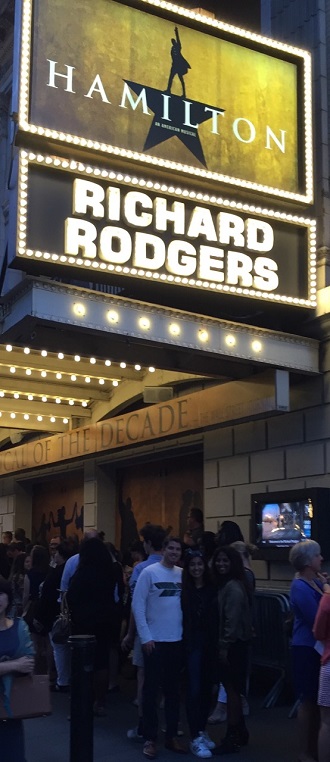
Linda: Before I saw Hamilton, I didn’t think it could exceed my expectations; I used to live in NYC so I’ve seen several popular plays on Broadway. Before I saw Hamilton, I listened to the Hamilton soundtrack so many times, seen lots of YouTube clips, discussed Ron Chernow’s biography (on which the show is based). I thought I knew how it was going to go, so I was completely unprepared. Blown away is the term I’d use, too. I agree the set, the lighting, the excitement of the audience, and especially the outstanding choreography makes the show – the production is so multi-layered that it transported me completely. When it ended, my first thought was, “When can I see this again?”
- What are the elements of the musical that make it especially effective in telling the story of Alexander Hamilton?
Linda: For me, the main thing that’s so amazing is that Lin-Manuel Miranda used hip hop rap tell a story which most of us who grew up here have learned in a rote, two dimensional way – making it fresh, relevant, and relatable. It rhymes, has catchy music, there’s dancing… and it’s fairly historically accurate? Incredible! I’m a little afraid that I’ll forever imagine the reputedly soft spoken George Washington as Chris Jackson. (And here’s a true story – when I lived in NYC, I met Chris Jackson when he was in Lion King as Simba, and even saw the play sitting in central orchestra – in his seats!)
Priya: Well that’s exciting. I heard Chris Jackson talk at a preview of Hamilton’s America the PBS Documentary (the Hamildoc). Since I saw an understudy for Washington (who was just as awesome) it was great to get to see him in person even if it wasn’t on the stage.
Anyway, for me the reason the show is effective is pretty obvious, specifically the way Miranda and his team took historical elements to make them have broad appeal. It’s not just what you see on stage – minorities (primarily African-Americans) playing white founding fathers, but also what isn’t seen. This is one of the reasons the show resonates with me, that despite its imperfections, that it isn’t all encompassing; the show has added to a dialogue (at least in the historical community) about race, class, and gender in public art. The best pieces of art push in all directions and Miranda certainly consciously and unconsciously did that.
Also, brief historian nerd out: I love how Miranda really listened and thought about the practice of history, and how we know what we know about the past – particularly Eliza’s song “Burn.” In a very real sense it works as a melody at this god awful moment in her life after learning of her husband’s affair (and we all know it is about to get worse with the death of her son). From a historical perspective the imbalance of written sources to tell the story of all classes of women – not just those from the landed gentry – is one of the hardest things about expanding the narrative beyond the ‘big white rich men’ that we often only hear about.
Also can I just say that the songs are ridiculously catchy?
- Much has been said about Lin-Manuel Miranda and his success in bringing his idea of a hip hop retelling of American history to life. How do you think he made it work?
Linda: What inspires me the most is Miranda’s vision. The vision to make a hip hop musical about Alexander Hamilton, Secretary of the Treasury, sounds completely crazy. Seriously, if he wasn’t on the ten dollar bill, would I even know who Alexander Hamilton was? Who could possibly be a more stiff seeming character? But Miranda was fascinated by him and his passion for Hamilton’s story – it’s brought us all along, too.
I’m so inspired by Miranda – to remember to stick to what turns me on creatively and let the rest follow. From his start creating In the Heights to Hamilton I can’t think of a better current example of “if you build it, they will come” role model than Miranda.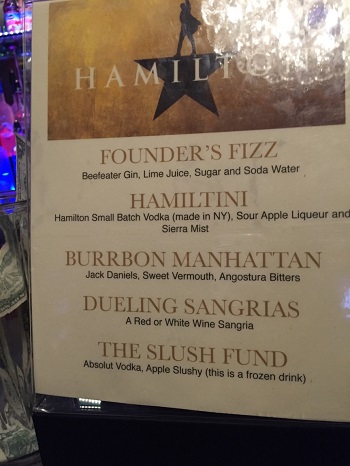
Priya: I really try to be careful with the gushing when I talk about Miranda. He really is driven, and I think nearly the same age as I am which sometimes makes me think about what else I can do myself. That actually might be a secondary inspiration for the show – just how his creativity and work pushes others to also think about making a change.
He also knows when to turn things off and focus on what’s important – and is very clear that his work doesn’t magically come to life, that it takes a village to get things done. I’m in the middle of Hamilton:The Revolution (aka the Hamiltome) and you can see how many creative geniuses had to come together to make it work.
Linda: I am just going to say I’m an unabashed Miranda gusher. I can’t help myself! But you’re right, Miranda talks a lot about the collaborative effort it took to put Hamilton together, and Miranda refers to his collaborators as his Cabinet. It would be impossible for the show to be such a hit without all the talent involved in staging it. That just makes me like Miranda more.
He reminds me of a modern, hipper, more inclusive George Lucas. Lucas also created a massive unlikely hit and surrounded himself with equal or more brilliant creators. I think of Miranda and Lucas as the shaman who held the vision of creative inspiration to make their stories happen.
- So let’s talk about Hamilton and Star Wars.
Linda: While I was sitting in the theater watching Hamilton, I was immediately reminded of Star Wars. The connections were immediate for me: ANH was released in 1977, a year after the bicentennial. Both stories feature disenfranchised farm (Luke) /plantation (Hamilton) boys, looking to elevate their mundane lives, looking for adventure, who stumble into a time of social upheaval, make wise allies (Obi Wan / George Washington) and hold their own vision to become heroes of a war.
It’s hard not to imagine that the American Revolutionary War, where our scrappy, untrained and poorly funded forces beat the country that ruled most of the world influenced elements of A New Hope and Star Wars in general, beyond just the similarity of archetypes.
Plus, I find both stories profoundly transporting.
Priya: I’m not sure I actually made a conscious connection between Hamilton and Star Wars. There are elements of a Shakespearean tragedy and the Hero’s Journey in the story, and the Revolution definitely fits the bill for going up against a big empire. But I actually see the threads of Star Wars in the people, yes it was primarily landed gentry, but there were heroes made from the lower classes who fought on principle and to quote the play “to rise up.”
Linda: You’re absolutely right. Part of the power of both stories is that they are archetypal stories and very much follow the hero’s journey.
Priya: Another note on Star Wars. When I watched the Hamildoc I realized that maybe Hamilton is more akin to Anakin (the man rather than the monster). He starts out wide-eyed and nervous (think his monologue at the tavern during my shot, below) and is propelled forward partially by the moment but also by a force of will and a want to do more, to be beyond his circumstances. You can really see in the second half how Hamilton’s hubris and arrogance really spiral out of control, and much like Anakin he does lose his life tragically (but without the whole rising from the dead as an evil Sith Lord part).
Sometimes I get over excited, shoot off at the mouth
I never had a group of friends before
I promise that I’ll make y’all proud
Linda: That’s an interesting point. Anakin/Vader is the archetype of the tragic hero, as is Hamilton.
- There are a lot of really great stories here about the male leaders of the revolution. What do you think Hamilton: An American Musical did well in portraying the lives and stories of women in that period?
Linda: I think it really made me aware of how important the women were behind the scenes and in making social ties which shape history in quiet ways. Angelica Schuyler Church really did meet Jefferson in Paris and they were also correspondents later in life. I’m sure she probably told him women are also created equal to men, as she said she would in the play.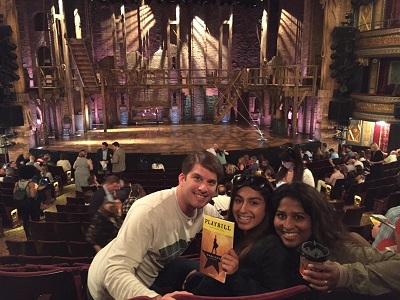
In the Reynolds affair, we see how a woman could undo a man’s reputation.
Eliza, though, really gives the play its heartfelt closure by picking up Hamilton’s work, saving much of his correspondence, working as an abolitionist and starting an orphanage. Going back to your earlier point about who writes history: we shouldn’t forget that what she saved also told what she wants us to remember about Hamilton. I wonder how much correspondence was “lost.”
As an aside, the John Adams movie shows how much an influence Abigail Adams was with John Adams. I imagine most wives played an important role for their husbands then, and we see with Hillary Clinton running for office now after her husband was president, just how much equality has been denied to women throughout history.
Priya: So there are a number of very cool things about the ladies in Hamilton – some of which I realized only after seeing the musical in person. If you were to just listen to the music you would think there are only four women in the show. Eliza, Peggy, Angelica and Maria Reynolds. You’ll also think that they are only in a few of the songs.
That would be false. In addition to the four named (played by three actresses) there are a number of female dancers that populate the stage not only as women (at the wedding for instance), but also on the field of battle as soldiers, and as spectators during some of the more political machinations. I realized this especially because I would always say “Peggy just disappears” when listening to the soundtrack, but you realize that she’s there the whole time, but is a part of the larger chorus.
Like I said earlier that’s one of the awesome undertones of this show. Women in the colonial period had a lot to say – we do have letters that survived between Angelica Schuyler Church and Thomas Jefferson or the other individuals she corresponded with, but that wasn’t always the case. Many women burned correspondence because they believed it was private.
There is so much we don’t know (but also a lot we do) about women of all classes and races in the colonial period
Linda: I think something which is so important about the staging of Hamilton, is that just as the Founding Fathers weren’t played by white men, women portrayed roles, as you noted, that were non-traditional for colonial times, like soldiers in battle scenes. I think that says a lot about how modern productions can be more inclusive, like how in The Force Awakens we see a lot more women in Imperial roles and pilot roles than were in A New Hope. We still have a long way to go, but it’s progress.
- What do you think are the strengths of the show’s storytelling? The pitfalls?
Linda: As I’ve been thinking about this more, I realized that I was so swept up in Hamilton because we see him taking the Hero’s Journey. It makes Hamilton the man compelling as a human being.
I don’t know enough about the structure of musicals/plays, but the repetition of motifs like “my shot” and “rise up” – how we see Hamilton thinks about his death in the beginning, middle and end of the musical – makes the story powerfully cohesive both in the storytelling and musical motifs.
There were lots of things that the lyrics cleverly tell us about the actual history of the Revolutionary War: how Hamilton takes the redoubt in the battle of Yorktown without using gunfire, how Rochambeau was the actual code word, King George’s song alludes to his eventual insanity, the hostility between Jefferson and Hamilton in the Cabinet debates.
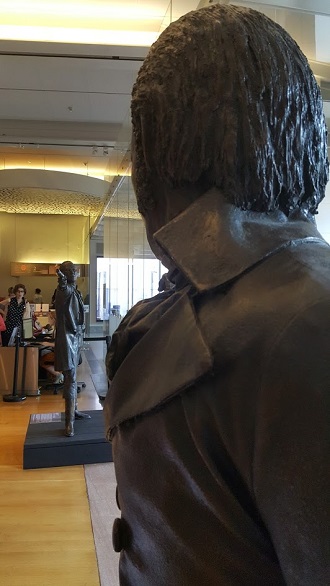 Weaknesses: there are a few historical inaccuracies – like the fact that Hercules Mulligan, Lafayette, Laurens, Burr, and Hamilton never actually hung out at a bar together drinking shots; “The World Turned Upside Down” was probably not played after the battle of Yorktown.
Weaknesses: there are a few historical inaccuracies – like the fact that Hercules Mulligan, Lafayette, Laurens, Burr, and Hamilton never actually hung out at a bar together drinking shots; “The World Turned Upside Down” was probably not played after the battle of Yorktown.
Also, I think that there is a good chance that Hamilton suffered from Bipolar Disorder – the Reynold’s affair, and “Nonstop” describes many symptoms consistent with the illness, but it’s never actually addressed in the play. Not to mention that Angelica was already married to a very intelligent and successful husband when she met Hamilton.
Priya: My thoughts in a nutshell…
Theatre is an interdisciplinary art form. Something that tackles all your senses at once – sight, touch, auditory, and smell (sometimes) creating a spectacle that is more tangible than a TV screen or a movie. One of the strengths of Hamilton is how it is faithful to its medium, but also tries to tread new ground artistically and musically. In reading the Hamiltome it is so wonderful to read about all the other visionaries involved beyond Lin-Manuel’s genius. At every step of the way there is a thoughtful process about how each of these pieces fit together, and also a focus on being truthful while also trying to pull in the texture and the emotion of the period.
This is somethings that historians often struggle with. We can write words on a page, but fail at actually conveying the import of history. With Hamilton: An American Musical you get both – while understanding that the sense of history is there, while not entirely 100% accurate.
And in the end, the way in which this creative team brought about this world makes it all the more powerful.
Priya Chhaya is a historian who loves the written word. When she’s not reading anything she can get her hands on she is writing about the past and its intersection in our daily lives on her personal blog …this is what comes next.
- The (Re)Ascendancy of Thrawn - February 19, 2022
- Get your Chiss On: A Review of Thrawn Ascendancy Chaos Rising - September 17, 2020
- Review: Shadow Fall (a Star Wars Alphabet Squadron Book) - June 26, 2020

